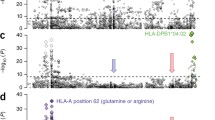Abstract
We compared the peptide binding specificity of three HLA-DQ molecules; HLA-DQ(α1*0501, β1*0201), HLA-DQ(α1*0201, β1*0202), and HLA-DQ(α1*0501, β1*0301). The first of these molecules confers susceptibility to celiac disease and insulin-dependent diabetes mellitus, while the two latter molecules, which share either the α chain or the nearly identical β chain with HLA-DQ(α1*0501, β1*0201), do not predispose to these disorders. The binding of peptides was detected in biochemical binding assays as inhibition of binding of radiolabeled indicator peptides to affinity-purified HLA-DQ molecules. Binding experiments with several peptides demonstrated a clear difference in peptide binding specificity between the three HLA-DQ molecules. Further, single amino acid substitution analyses indicated that the HLA-DQ molecules have different peptide binding motifs. The experimental data were corroborated by computer modelling analysis. Our data suggest that the three HLA-DQ molecules prefer large hydrophobic residues in P1 of peptides with subtle differences in side-chain preferences. HLA-DQ(α1*0501, β1*0201) and HLA-DQ(α1*0201, β1*0202) both prefer large hydrophobic residues in P9, whereas HLA-DQ(α1*0501, β1*0301) prefers much smaller residues in this position. HLA-DQ(α1*0501, β1*0201) and HLA-DQ(α1*0201, β1*0202), in contrast to HLA-DQ(α1*0501, β1*0301), prefer negatively charged residues in P4 and P7. A less prominent P6 pocket also appears to differ between the three HLA-DQ molecules. Our results indicate that polymorphic residues of both the α and the β chain determine the peptide binding specificity of HLA-DQ(α1*0501, β1*0201), but that the β chain polymorphisms appears to play the most important role. The information on peptide residues which are advantageous and deleterious for binding to these HLA-DQ molecules may make possible the prediction of characteristic features of peptide that bind to HLA-DQ(α1*0501, β1*0201) and precipitate celiac disease.
Similar content being viewed by others
Author information
Authors and Affiliations
Additional information
Received: 2 July 1996 / Revised: 7 August 1995
Rights and permissions
About this article
Cite this article
Johansen, B., Jensen, T., Thorpe, C. et al. Both α and β chain polymorphisms determine the specificity of the disease-associated HLA-DQ2 molecules, with β chain residues being most influential. Immunogenetics 45, 142–150 (1996). https://doi.org/10.1007/s002510050182
Issue Date:
DOI: https://doi.org/10.1007/s002510050182




